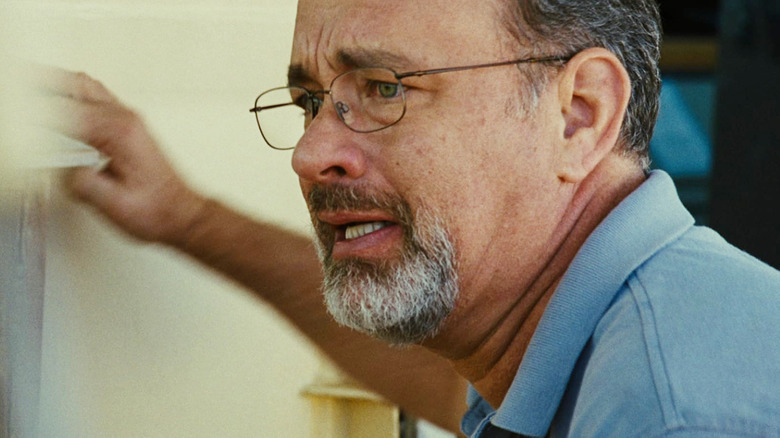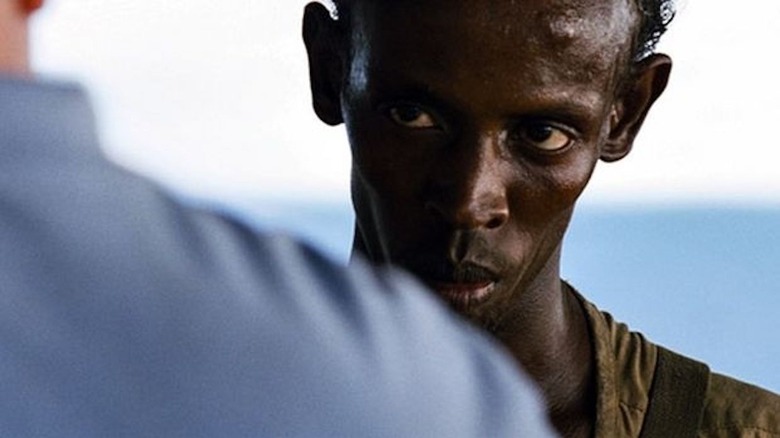Tom Hanks And The Somali Pirates Had To Be Kept Separate During Captain Phillips
Paul Greengrass makes harrowing movies. He established this with his gripping 2002 Northern Ireland docudrama "Bloody Sunday," which was his springboard to Hollywood, where he turned the Jason Bourne franchise into a master class in jittery, handheld, shoot-for-the-edit cinema. These successes for Universal compelled the studio to take a managed $15 million risk on Greengrass' "United 93," his masterful staging of the heroic events that transpired on the fourth hijacked plane, which thankfully did not reach its target, on 9/11. It's his best film to date, but one that's also way too intense for many people to endure — which can also be said of his biographical thriller "Captain Phillips."
The account of Somali pirates hijacking the shipping vessel Maersk Alabama in 2009 stars Tom Hanks as the title skipper who managed to engineer the rescue of himself and his crew from the ship. It's shot in Greengrass' trademark docudrama style, which means a lot of shaky cameras, quick cutting, and an overall sense of jacked-up tension where it feels like anyone can get killed at any given moment. This anxiousness is especially jarring because you're used to Hanks being a calming presence. Even in "Saving Private Ryan," he's able to get us feeling at ease, but in "Captain Phillips" he's walking a tightrope for two hours as he attempts to appease the gun-toting Somali pirates and plot his escape.
One of the most challenging aspects of making the film was ensuring that the non-professional actors playing the hijackers didn't get starstruck in the presence of Hanks — or, worse, get to know him. After all, Hanks' reputation for affability is well-earned; all you need is a minute in his presence to feel special and bound to him for life. So, Greengrass did the only thing he could: he kept 'em separated.
The importance of de-mystifying Tom Hanks
In a 2013 interview with NPR, Greengrass revealed that he kept two-time Academy Award-winner Hanks away from his cast's first-timers (which included the soon-to-be-Academy-Award-nominated Barkhad Abdi) for fear that the latter might be intimidated by the man who was Gump. He was also mindful of Hanks' blasted niceness. According to Greengrass, "[I] didn't want them to have become friends, because in the end the job was to come through that door and terrorize and threaten and be believable."
Greengrass' strategy paid off with an air of anticipation that charged up everyone on set. As he told NPR:
"When you're a director, you... [are] trying to create moments that everybody's looking forward to in a shoot. If there's something that's two, three weeks down the road where everybody's going 'That's going to be an exciting day when those two groups meet each other.' And I think it got everybody excited and, you know, you could feel the set was — there was a good tension in the air."
That electricity probably worked more in Abdi's favor, because, having never seen him before in a single movie, we had no idea what to expect from him performance-wise. It's a stunning turn — a half-menacing, half-sympathetic blend of wiry physicality and lock-eyed intensity. He's not intimidated by Hanks, and he's not trying to be the man's friend (if anything, it's Hanks doing the attempted bonding). Greengrass' gamble hit the jackpot, which is why "Captain Phillips" (which made /Film's list of 12 Best Navy SEAL Movies) is every bit as gripping today as it was back in 2013.

